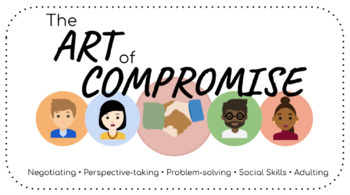Social Skills The Art of Compromise for Google Slides™
SLP KEN
125 Followers
Grade Levels
Not Grade Specific
Resource Type
Standards
CCSSSL.9-10.1
CCSSSL.9-10.1b
CCSSSL.9-10.1c
CCSSSL.9-10.1d
CCSSSL.9-10.6
Formats Included
- Google Slides™
Pages
135 pages
SLP KEN
125 Followers

Made for Google Drive™
This resource can be used by students on Google Drive or Google Classroom. To access this resource, you’ll need to allow TPT to add it to your Google Drive. See our FAQ and Privacy Policy for more information.
Description
The Art of Compromise is a presentation to help students increase their social skills. The presentation can be used for individual students or groups. The presentation includes clear instructions, skills steps, and examples. The Art of Compromise helps students increase...
- Negotiation and compromise skills
- Perspective-taking
- Problem-solving
- Social interaction and communication
- Respectful language use
- Justification skills
- Self-reflection
Contents include
- 30 lessons
- Perspectives from different people, such as parents, siblings, co-workers, boss, friends, and significant others
- Diverse cultures and individuals depicted in the clipart
- Wide-range of everyday situations requiring negotiation
If you find this resource helpful, a workbook version geared for individual use for purchase on my TpT site.
Total Pages
135 pages
Answer Key
N/A
Teaching Duration
1 Year
Last updated Jun 15th, 2021
Report this resource to TPT
Reported resources will be reviewed by our team. Report this resource to let us know if this resource violates TPT’s content guidelines.
Standards
to see state-specific standards (only available in the US).
CCSSSL.9-10.1
Initiate and participate effectively in a range of collaborative discussions (one-on-one, in groups, and teacher-led) with diverse partners on grades 9–10 topics, texts, and issues, building on others’ ideas and expressing their own clearly and persuasively.
CCSSSL.9-10.1b
Work with peers to set rules for collegial discussions and decision-making (e.g., informal consensus, taking votes on key issues, presentation of alternate views), clear goals and deadlines, and individual roles as needed.
CCSSSL.9-10.1c
Propel conversations by posing and responding to questions that relate the current discussion to broader themes or larger ideas; actively incorporate others into the discussion; and clarify, verify, or challenge ideas and conclusions.
CCSSSL.9-10.1d
Respond thoughtfully to diverse perspectives, summarize points of agreement and disagreement, and, when warranted, qualify or justify their own views and understanding and make new connections in light of the evidence and reasoning presented.
CCSSSL.9-10.6
Adapt speech to a variety of contexts and tasks, demonstrating command of formal English when indicated or appropriate.





